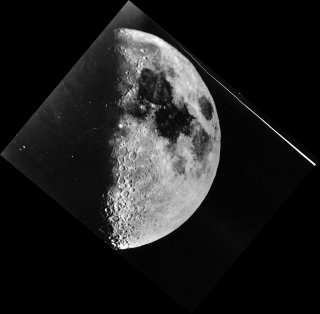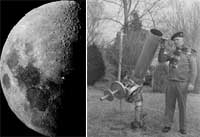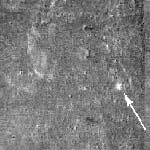presents
Illuminated Moving Target: - 1956?
Explained!! An Impactor!

Francis Ridge:
The Lunascan Project refers to objects observed
which appear to be moving above the lunar surface as "fastwalkers" (these
are dark objects) or "FMOs" (Fast-Moving Objects) or "IMTs" (Illuminated
Moving Targets). Initially this report fell under the latter description.
However, recently we learned that this object did not "move", but impacted
on the Moon! What a great find!
Several years ago, a noted UFOlogist provided an interesting photograph of the Moon. This black and white photograph had never been previously published to our knowledge, except in a small and now-defunct publication known as The Heartland UFO Journal. It turns out that the photo had stirred controversey earlier than we had thought. Supposedly, one evening in June or July of 1956 the director of a major observatory in the Midwestern United States had taken the picture and the object had been moving. The photo we had was a "reversed image" and had to be "flipped" over to show the proper surface detail registration. The image above is the corrected one.
On February 20, 2003 NASA released the following report and I recognized the photo as being the enigmatic photo we had posted earlier. See full NASA release below the images.
Francis Ridge
Coordinator,
The Lunascan Project


RELEASE: 03-077
NASA SOLVES HALF-CENTURY OLD MOON MYSTERY
In the early morning hours of Nov. 15, 1953,
an amateur astronomer in Oklahoma photographed what he believed to be a
massive, white-hot fireball of vaporized rock rising from the center of
the moon's face. If his theory was right, Dr. Leon Stuart would be the
first and only human in history to witness and document the impact of an
asteroid-sized body impacting the moon's scarred exterior.
Almost a half-century, numerous space probes
and six manned lunar landings later, what had become known in astronomy
circles, as "Stuart's Event" was still an unproven, controversial theory.
Skeptics dismissed Stuart's data as inconclusive and claimed the flash
was a result of a meteorite entering Earth's atmosphere. That is, until
Dr. Bonnie J. Buratti, a scientist at NASA's Jet Propulsion Laboratory
(JPL) in Pasadena, and Lane Johnson of Pomona College, Claremont, Calif.,
took a fresh look at the 50-year-old lunar mystery.

"Stuart's remarkable photograph of the collision gave us an excellent starting point in our search," said Buratti. "We were able to estimate the energy produced by the collision. But we calculated that any crater resulting from the collision would have been too small to be seen by even the best Earth-based telescopes, so we looked elsewhere for proof."
Buratti and Lane's reconnaissance of the 35-kilometer (21.75-mile) wide region where the impact likely occurred led them to observations made by spacecraft orbiting the moon. First, they dusted off photographs taken from the Lunar Orbiter spacecraft back in 1967, but none of the craters appeared a likely candidate. Then they consulted the more detailed imagery taken from the Clementine spacecraft in 1994.
"Using Stuart's photograph of the lunar flash, we estimated the object that hit the moon was approximately 20 meters (65.6 feet) across, and the resulting crater would be in the range of one to two kilometers (.62 to 1.24 miles) across. We were looking for fresh craters with a non-eroded appearance," Buratti said.
Part of what makes a moon crater look "fresh"
is the appearance of a bluish tinge to the surface. This bluish tinge indicates
lunar soil that is relatively untouched by a process called "space weathering,"
which reddens the soil. Another indicator of a fresh crater is that it
reflects distinctly more light than the surrounding area.
Buratti and Lane's search of images from the Clementine mission revealed a 1.5-kilometer (0.93 mile) wide crater. It had a bright blue, fresh-appearing layer of material surrounding the impact site, and it was located in the middle of Stuart's photograph of the 1953 flash. The crater's size is consistent with the energy produced by the observed flash; it has the right color and reflectance, and it is the right shape. Having the vital statistics of Stuart's crater, Buratti and Lane calculated the energy released at impact was about .5 megatons (35 times more powerful than the Hiroshima atomic bomb). They estimate such events occur on the lunar surface once every half-century.
"To me this is the celestial equivalent of observing a once-in-a-century hurricane," observed Buratti. "We're taught the moon is geologically dead, but this proves that it is not. Here we can actually see weather on the moon," she said.
While Dr. Stuart passed on in 1968, his son Jerry Stuart offered some thoughts about Buratti and Lane's findings. "Astronomy is all about investigation and discovery. It was my father's passion, and I know he would be quite pleased," he said.
Buratti and Lane's study appears in the latest issue of the space journal, Icarus.
The NASA Planetary Geology and Planetary Astronomy Programs and the National Science Foundation funded Buratti's work. The California Institute of Technology manages JPL for NASA.
More information about NASA's planetary missions,
astronomical observations, and laboratory
measurements is
available on the Internet at:
http://pds.jpl.nasa.gov
Information about NASA programs is available
on the Internet
at:
www.nasa.gov
-end-
Lunascan
Home Page
